ABSTRACT
Elimination of pesticides and heavy metals residues in agricultural products is a key to successful adoption of Vietnamese Good Agricultural Practices (VietGAPs). However, abuse of pesticides and fertilizers in agricultural production still exists in some crops. The objective of this study is to explore the application of VietGAPs for reducing the use of pesticides and fertilizers in the production of rice, vegetables and tea in some provinces of Vietnam. The results of survey and analysis showed that soil and water in the rice fields of Bac Ninh province, vegetable farms of Hanoi and tea farms in Phu Tho provinces were not contaminated with pesticides and heavy metals. By training and guiding of farmers for VietGAPs implementation, the number of pesticides and chemical applications is reduced 2-3 times per crop season. This implimentation not only reduced the amount of chemical fertilizers but also increased the use of organic fertilizers in the models. Our study also revealed that the GAPs manual should be simplified to suit each GAPs crop for farmers to easily understand and apply.
Keywords: Good Agricultural Practices (GAPs), pesticides and fertilizers, rice, vegetables, tea, Vietnam
INTRODUCTION
Over the past decade, food production has markedly changed on area, yield, production, types and especially in the requirements for food safety in Vietnam. Food safety has been a major concern for Vietnamese central and local government and people, and has led to the issue of the decree No. 379/QD-BNN-KHCN on 28 January 2008 by the Ministry of Agriculture and Rural Development (MARD)that established Vietnamese Good Agricultural Practices (VietGAPs). The aim of VietGAPs is to prevent and minimise the risk of hazards which may occur during production, harvesting, and post-harvest handling of crops. VietGAP was developed based on GlobalGAPs and it provides standard for: a) site assessment and selection, b) planting material, c) soil and substance management, d) fertilizers and soil additives, e) water and irrigation, f) crop protection and use of chemicals, g) harvesting and post harvest handling, h) waste management and treatment, i) workers’ health and welfare, and j) record keeping, traceability and recall (VietGAPs, 2008).
MARD has issued the regulations on farming products which include vegetables, fruits, tea, coffee, pepper and rice that meet VietGaps standards. These agricultural products must have to complete the certification process and enjoyed (?) a number of policies for supporting good agricultural practices application. According to statistics of MARD, total rice production area in Vietnam is about 7.89 million ha, of which about 550 ha have been certified by VietGAPs. Total vegetable production is estimated to be about 735,000 ha, of which around 62,503 ha have been certified by VietGAPs. Total tea production is estimated to be about 140,000 ha, of which about 400 ha have been certified by VietGAPs (MARD, 2013).
There are many documents issued regarding to policy and management of food safety, but actual food poisoning still occurs which is caused by residue of chemicals and harmful microorganisms in food. Therefore, the propaganda and guidance for farmers to practice good agriculture to produce safe products are still being implemented in Vietnam. Three models of VietGAPs (one model for one crop) were conducted in rice, vegetables and tea by the Plant Protection Research Institute (PPRI) in collaboration with the local agricultural extensionists and farmers in the Northern part of Vietnam.
METHODOLOGY
Three local locations in Nothern of Vietnam were selected for the development of VietGAP models, including: 50 ha rice (Oryza sativa) in Yen Phu village - Yen Phong district - Bac Ninh Province; 15 ha vegetable at Linh Nam village - Hoang Mai ward - Hanoi City; and 25 ha tea (Camellia sinensis (L) O. Kuntze) at Phu Ho village - Phu Tho town - Phu Tho province. The use of fertilizers (chemical fertilizers and organic fertilizers) and pesticides (chemical pesticides and biological control agent) in models were recorded and analysed.
The pre-survey was conducted by interviewing 30 farmers, local agricultural extensionists in each local area regarding information on rice, vegetables and tea production, especially focusing on technical application including fertilizers and pesticides. Compilation of technical documentation for farmers and local extentionists about VietGAPs implementation was also done. Testing of heavy metals and pesticide residues in soil and water before conducting models and post-harvesting of agricultural products were conducted by using GC/MS, HPLC and AAS.
RESULTS
Survey on current status of areas for VietGAP implementation in rice, vegetables and tea production.
Location for rice production following VietGAPs standards, about 50 ha, belong to Yen Phu village - Yên Phong district - Bac Ninh province in Red river delta, total area for rice production about 293 ha, with two seasons per year. Soil, water, irrigation and local transportation, pesticides and fertilizer storages are suitable for requirements of VietGAP standards. The heavy metals and pesticide residue analysis of soil and water in the area for VietGAPs implementation showed that these numbers were under standard level of National technical regulation on the allowable limits of heavy metals in soils (QCVN 03:2008/BTNMT) and the National technical regulation on the allowable limits of heavy metals in water (QCVN 039:2011/BTNMT) (Tables 1,2).
Table 1. Results for analysis of heavy metal in water samples in Yen Phu - Yen Phong - Bac Ninh

Unit mg/kg (mg heavy metal per litter of waterl)
Table 2. Results for analysis of heavy metal in soil samples in Yen Phu - Yen Phong - Bac Ninh
Unit mg/kg (mg heavy metal per kilogram dried soil)
Linh Nam village - Hoang Mai ward - Hanoi is a commune with intensive vegetable production with 100 ha for growing vegetables. Cooperative management board has been performing a process to produce safe vegetables with high quality products. Farmers have their own land, therefore, vegetable safety products depend on the level of technical application by households. Based on this fact, the Cooperative has decided to allot 10 ha of vegetables following VietGAPs model. Infrastructure includes net houses to prevent rain and sun light to produce leafy vegetables, plastic pine system for irrigation, processing and packaging system was built. Althought farmers have good experiences in production of safe vegetables, they lack knowledge in VietGAPs, especially they still use chemical pesticides with high rate of spaying and mixed several pesticides for one application (Table 3). The heavy metals and pesticide residue analysis of soil and water in the area for VietGAPs implementation showed that these indexes were under standard levels of National technical regulation on the allowable limits of heavy metals in soils (QCVN 03:2008/BTNMT) and National technical regulation on the allowable limits of heavy metals in water (QCVN 039:2011/BTNMT) (Tables 4,5).
Table 3. List of chemical pesticides use for control pests in vegetable field in Linh Nam – Hoang Mai - Hanoi

Table 4. Results for analysis of heavy metal in water samples in Linh Nam - Hoang Mai - Hanoi

Unit mg/kg (mg heavy metal per litter of waterl)
Table 5. Results for analysis of heavy metal in soil samples in Linh Nam - Hoang Mai - Hanoi
.jpg)
Unit mg/kg (mg heavy metal per kilogram dried soil)
Phu Ho village, Phu Tho town, Phu Tho province lead the midlands of the mountains in the Northern part of Vietnam. Natural conditions in Phu Tho province are suitable for growing tea with a total of 15.700 ha of tea plantation in this region. The area for developing VietGAPs is around 25 ha, with infrastructure which includes water, irrigation and local transportation, pesticide and fertilizer storages was well established. The heavy metals and pesticide residue analysis of soil and water in the area for VietGAPs’ implementation showed that these data were under standard levels of the National technical regulation on the allowable limits of heavy metals in soils (QCVN 03:2008/BTNMT) and National technical regulations on the allowable limits of heavy metals in water (QCVN 039:2011/BTNMT) (Tables 6, 7).
Table 6. Results for analysis of heavy metal in water samples in Phu Ho - Phu Tho

Unit mg/kg (mg heavy metal per litter of waterl)
Table 7. Results for analysis of heavy metal in soil samples in Phu Ho - Phu Tho

Unit mg/kg (mg heavy metal per kilogram dried soil)
VietGAPs models
Training farmers for VietGAPs.
The new technical documentations were released by a combination of local production process for vegetables and VietGAP standards. Fifteen farmer classes of VietGAPs for rice, vegetables and tea were organized with 300 famers attending. Through the training, farmers understand more about the technical methods for rice, vegetables and tea safety production, such as: how to use the manure and chemical fertilizers in products without excess NO3- and without harmful micro-organism, how to use pesticides according to four right principles, and no arbitrary increasing of dosage by mixing two or three pesticides in one spraying emulsion. Farmers’ VietGAPs implementaion ensured that no pesticide residues exceed the permitted level of the FAO/WHO or standard level of Vietnam in rice, vegetables and tea, and farmers were encouraged to use biological control agents and only use chemical pesticides in case it is necessary. The farmers families knew how to keep a record of their activities for VietGAPs in a convinient and easy way.
Development of VietGAPs models for rice, vegetables and tea production.
Fifty hectares of rice used sticky rice seeds, with attending of 200 rice growing households, were cultivated following the VietGAPs standards. Fertilizer application for VietGAPs model is shown in Table 8. The main pests appeared inside and outside of models with pesticides and time for spray are given in Table 9. Chemical pesticides were used for inside and outside models as shown in Table 9. Analysis of pesticide residue on rice samples after harvesting is shown in Table 10. Economic efficiency of reduced number of pesticide sprays between inside and outside VietGAP models is shown in Table 11.
Ten hectares of vegetables, with many kinds of leafy vegetables, attended by 50 vegetable growing households, were cultivated following the VietGAPs standards. The main pests appeared inside and outside models with pesticides and time for spray are given inTable 12. Economic efficiency of reducing the number of pesticide sprays between VietGAPs and normal models are shown in Table 13..
Twenty-five hectares of tea plantation , attended by 50 households, were cultivated following the VietGAPs standards. The main pests appeared inside and outside of models with pesticides and time for spray are given in Table 14. The economic efficiency of reducing the number of pesticide application between VietGAPs and farmer models was given in the Table 15.
Table 8. Process for application of fertilizers in VietGAP model for rice production
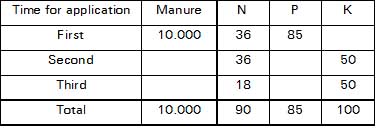
Unit kg/ha
Table 9. Main pests, pesticide and time for spray in season in rice field
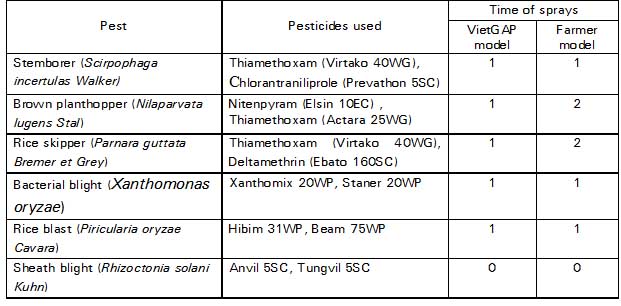
Table 10. Analysis of pesticide residue in rice samples with VietGAP afer harvesting
nd: none detection
Table 11. Economic efficiency of pesticide using between VietGAP and normal models in rice production per hectare
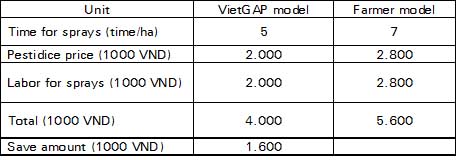
Table 12. Main pests, pesticide and time for spray in season in vegetable fields
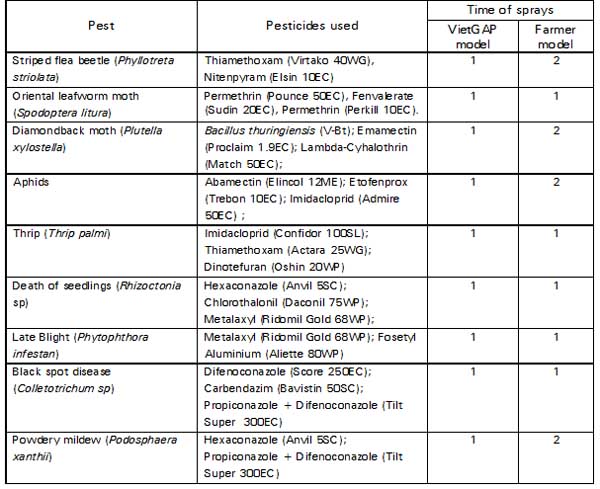
Table 13. Economic efficiency of pesticide using between VietGAP and normal models in vegetables production per hectare
.jpg)
Table 14. Main pests, pesticides and time for spray in season in tea fields
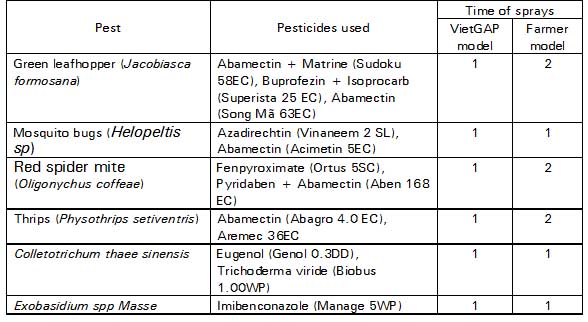
Table 15. Economic efficiency of pesticide using between VietGAP and normal models in tea production per hectare
.jpg)
CONCLUSION
This study investigates and compares the farming practices of selected farms ofthree main crops (rice, vegetables, and tea) are grown under VietGAPs model and ones grown under t farmer practices (traditional) model in the Northern part of Vietnam.
Results of analysis of soil and water showed that most of the area for growing crops in Vietnam are not contaminated by heavy metals and pesticides.
There are 21 active ingridients of pesticides are being used for control of main pests in rice, vegetables and tea. The number of pesticide applications in the normal model was usually higher than that of the VietGAPs model, increased the costs for production.
Farmers will successfully apply VietGAPs models if there are suitable policies for training of them and the information about them is disseminated in media. VietGAPs should be expanded in large areas and used for other agricultural crops.
REFERENCES
VietGAPS (2008) Good agricultural practices for production of safe fresh fruit and vegetables in VietNam (VietGAP). Hanoi. Ministry of Agricultrue and Rural Development, pp23.
Vuong, P.T., N.T. Nhung., N.T. Thuy., D.T. Hang., T.Q.Viet., D.T.Luong and N.T.Q.Trang, 2010. Development of safe vegetable production for improving generation income of household and protecting of rural environment in Vietnam. Journal of Vietnamese Agricultural Science and Technology 1 (14). 43-49.
Oleg, N., E.V.D. Fliert., H.V.Chien., V.Mai and L.Cuong, 2010. Good Agricultural Practice (GAP) as a vehicle for transformation to sustainable citrus production in the Mekong Delta of Vietnam. 9th European IFSA Symposium, 1893-1901.
Gazi, M.N.I., F.M.Arshad., A.Radam., E.F.Alias, 2012. Good agricultural practice (GAP) of tomatoes in Malaysia: Evidences from Cameron Highland. Africa Journal of Business Management. 6(27). 7969-7976.
|
Submitted for the FFTC-KU International Workshop on Risk Management on Agrochemicals through Novel Technologies for Food Safety in Asia, November 10-14, Sampran Riverside, Nakorn Pathom, Thailand |


Development of Good Agricultural Practices (GAPs) Models for Tea, Rice and Vegetables in Vietnam
ABSTRACT
Elimination of pesticides and heavy metals residues in agricultural products is a key to successful adoption of Vietnamese Good Agricultural Practices (VietGAPs). However, abuse of pesticides and fertilizers in agricultural production still exists in some crops. The objective of this study is to explore the application of VietGAPs for reducing the use of pesticides and fertilizers in the production of rice, vegetables and tea in some provinces of Vietnam. The results of survey and analysis showed that soil and water in the rice fields of Bac Ninh province, vegetable farms of Hanoi and tea farms in Phu Tho provinces were not contaminated with pesticides and heavy metals. By training and guiding of farmers for VietGAPs implementation, the number of pesticides and chemical applications is reduced 2-3 times per crop season. This implimentation not only reduced the amount of chemical fertilizers but also increased the use of organic fertilizers in the models. Our study also revealed that the GAPs manual should be simplified to suit each GAPs crop for farmers to easily understand and apply.
Keywords: Good Agricultural Practices (GAPs), pesticides and fertilizers, rice, vegetables, tea, Vietnam
INTRODUCTION
Over the past decade, food production has markedly changed on area, yield, production, types and especially in the requirements for food safety in Vietnam. Food safety has been a major concern for Vietnamese central and local government and people, and has led to the issue of the decree No. 379/QD-BNN-KHCN on 28 January 2008 by the Ministry of Agriculture and Rural Development (MARD)that established Vietnamese Good Agricultural Practices (VietGAPs). The aim of VietGAPs is to prevent and minimise the risk of hazards which may occur during production, harvesting, and post-harvest handling of crops. VietGAP was developed based on GlobalGAPs and it provides standard for: a) site assessment and selection, b) planting material, c) soil and substance management, d) fertilizers and soil additives, e) water and irrigation, f) crop protection and use of chemicals, g) harvesting and post harvest handling, h) waste management and treatment, i) workers’ health and welfare, and j) record keeping, traceability and recall (VietGAPs, 2008).
MARD has issued the regulations on farming products which include vegetables, fruits, tea, coffee, pepper and rice that meet VietGaps standards. These agricultural products must have to complete the certification process and enjoyed (?) a number of policies for supporting good agricultural practices application. According to statistics of MARD, total rice production area in Vietnam is about 7.89 million ha, of which about 550 ha have been certified by VietGAPs. Total vegetable production is estimated to be about 735,000 ha, of which around 62,503 ha have been certified by VietGAPs. Total tea production is estimated to be about 140,000 ha, of which about 400 ha have been certified by VietGAPs (MARD, 2013).
There are many documents issued regarding to policy and management of food safety, but actual food poisoning still occurs which is caused by residue of chemicals and harmful microorganisms in food. Therefore, the propaganda and guidance for farmers to practice good agriculture to produce safe products are still being implemented in Vietnam. Three models of VietGAPs (one model for one crop) were conducted in rice, vegetables and tea by the Plant Protection Research Institute (PPRI) in collaboration with the local agricultural extensionists and farmers in the Northern part of Vietnam.
METHODOLOGY
Three local locations in Nothern of Vietnam were selected for the development of VietGAP models, including: 50 ha rice (Oryza sativa) in Yen Phu village - Yen Phong district - Bac Ninh Province; 15 ha vegetable at Linh Nam village - Hoang Mai ward - Hanoi City; and 25 ha tea (Camellia sinensis (L) O. Kuntze) at Phu Ho village - Phu Tho town - Phu Tho province. The use of fertilizers (chemical fertilizers and organic fertilizers) and pesticides (chemical pesticides and biological control agent) in models were recorded and analysed.
The pre-survey was conducted by interviewing 30 farmers, local agricultural extensionists in each local area regarding information on rice, vegetables and tea production, especially focusing on technical application including fertilizers and pesticides. Compilation of technical documentation for farmers and local extentionists about VietGAPs implementation was also done. Testing of heavy metals and pesticide residues in soil and water before conducting models and post-harvesting of agricultural products were conducted by using GC/MS, HPLC and AAS.
RESULTS
Survey on current status of areas for VietGAP implementation in rice, vegetables and tea production.
Location for rice production following VietGAPs standards, about 50 ha, belong to Yen Phu village - Yên Phong district - Bac Ninh province in Red river delta, total area for rice production about 293 ha, with two seasons per year. Soil, water, irrigation and local transportation, pesticides and fertilizer storages are suitable for requirements of VietGAP standards. The heavy metals and pesticide residue analysis of soil and water in the area for VietGAPs implementation showed that these numbers were under standard level of National technical regulation on the allowable limits of heavy metals in soils (QCVN 03:2008/BTNMT) and the National technical regulation on the allowable limits of heavy metals in water (QCVN 039:2011/BTNMT) (Tables 1,2).
Table 1. Results for analysis of heavy metal in water samples in Yen Phu - Yen Phong - Bac Ninh
Unit mg/kg (mg heavy metal per litter of waterl)
Table 2. Results for analysis of heavy metal in soil samples in Yen Phu - Yen Phong - Bac Ninh
Linh Nam village - Hoang Mai ward - Hanoi is a commune with intensive vegetable production with 100 ha for growing vegetables. Cooperative management board has been performing a process to produce safe vegetables with high quality products. Farmers have their own land, therefore, vegetable safety products depend on the level of technical application by households. Based on this fact, the Cooperative has decided to allot 10 ha of vegetables following VietGAPs model. Infrastructure includes net houses to prevent rain and sun light to produce leafy vegetables, plastic pine system for irrigation, processing and packaging system was built. Althought farmers have good experiences in production of safe vegetables, they lack knowledge in VietGAPs, especially they still use chemical pesticides with high rate of spaying and mixed several pesticides for one application (Table 3). The heavy metals and pesticide residue analysis of soil and water in the area for VietGAPs implementation showed that these indexes were under standard levels of National technical regulation on the allowable limits of heavy metals in soils (QCVN 03:2008/BTNMT) and National technical regulation on the allowable limits of heavy metals in water (QCVN 039:2011/BTNMT) (Tables 4,5).
Table 3. List of chemical pesticides use for control pests in vegetable field in Linh Nam – Hoang Mai - Hanoi
Table 4. Results for analysis of heavy metal in water samples in Linh Nam - Hoang Mai - Hanoi
Unit mg/kg (mg heavy metal per litter of waterl)
Table 5. Results for analysis of heavy metal in soil samples in Linh Nam - Hoang Mai - Hanoi
Unit mg/kg (mg heavy metal per kilogram dried soil)
Phu Ho village, Phu Tho town, Phu Tho province lead the midlands of the mountains in the Northern part of Vietnam. Natural conditions in Phu Tho province are suitable for growing tea with a total of 15.700 ha of tea plantation in this region. The area for developing VietGAPs is around 25 ha, with infrastructure which includes water, irrigation and local transportation, pesticide and fertilizer storages was well established. The heavy metals and pesticide residue analysis of soil and water in the area for VietGAPs’ implementation showed that these data were under standard levels of the National technical regulation on the allowable limits of heavy metals in soils (QCVN 03:2008/BTNMT) and National technical regulations on the allowable limits of heavy metals in water (QCVN 039:2011/BTNMT) (Tables 6, 7).
Table 6. Results for analysis of heavy metal in water samples in Phu Ho - Phu Tho
Unit mg/kg (mg heavy metal per litter of waterl)
Table 7. Results for analysis of heavy metal in soil samples in Phu Ho - Phu Tho
Unit mg/kg (mg heavy metal per kilogram dried soil)
VietGAPs models
Training farmers for VietGAPs.
The new technical documentations were released by a combination of local production process for vegetables and VietGAP standards. Fifteen farmer classes of VietGAPs for rice, vegetables and tea were organized with 300 famers attending. Through the training, farmers understand more about the technical methods for rice, vegetables and tea safety production, such as: how to use the manure and chemical fertilizers in products without excess NO3- and without harmful micro-organism, how to use pesticides according to four right principles, and no arbitrary increasing of dosage by mixing two or three pesticides in one spraying emulsion. Farmers’ VietGAPs implementaion ensured that no pesticide residues exceed the permitted level of the FAO/WHO or standard level of Vietnam in rice, vegetables and tea, and farmers were encouraged to use biological control agents and only use chemical pesticides in case it is necessary. The farmers families knew how to keep a record of their activities for VietGAPs in a convinient and easy way.
Development of VietGAPs models for rice, vegetables and tea production.
Fifty hectares of rice used sticky rice seeds, with attending of 200 rice growing households, were cultivated following the VietGAPs standards. Fertilizer application for VietGAPs model is shown in Table 8. The main pests appeared inside and outside of models with pesticides and time for spray are given in Table 9. Chemical pesticides were used for inside and outside models as shown in Table 9. Analysis of pesticide residue on rice samples after harvesting is shown in Table 10. Economic efficiency of reduced number of pesticide sprays between inside and outside VietGAP models is shown in Table 11.
Ten hectares of vegetables, with many kinds of leafy vegetables, attended by 50 vegetable growing households, were cultivated following the VietGAPs standards. The main pests appeared inside and outside models with pesticides and time for spray are given inTable 12. Economic efficiency of reducing the number of pesticide sprays between VietGAPs and normal models are shown in Table 13..
Twenty-five hectares of tea plantation , attended by 50 households, were cultivated following the VietGAPs standards. The main pests appeared inside and outside of models with pesticides and time for spray are given in Table 14. The economic efficiency of reducing the number of pesticide application between VietGAPs and farmer models was given in the Table 15.
Table 8. Process for application of fertilizers in VietGAP model for rice production
Unit kg/ha
Table 9. Main pests, pesticide and time for spray in season in rice field
Table 10. Analysis of pesticide residue in rice samples with VietGAP afer harvesting
Table 11. Economic efficiency of pesticide using between VietGAP and normal models in rice production per hectare
Table 12. Main pests, pesticide and time for spray in season in vegetable fields
Table 13. Economic efficiency of pesticide using between VietGAP and normal models in vegetables production per hectare
Table 14. Main pests, pesticides and time for spray in season in tea fields
Table 15. Economic efficiency of pesticide using between VietGAP and normal models in tea production per hectare
CONCLUSION
This study investigates and compares the farming practices of selected farms ofthree main crops (rice, vegetables, and tea) are grown under VietGAPs model and ones grown under t farmer practices (traditional) model in the Northern part of Vietnam.
Results of analysis of soil and water showed that most of the area for growing crops in Vietnam are not contaminated by heavy metals and pesticides.
There are 21 active ingridients of pesticides are being used for control of main pests in rice, vegetables and tea. The number of pesticide applications in the normal model was usually higher than that of the VietGAPs model, increased the costs for production.
Farmers will successfully apply VietGAPs models if there are suitable policies for training of them and the information about them is disseminated in media. VietGAPs should be expanded in large areas and used for other agricultural crops.
REFERENCES
VietGAPS (2008) Good agricultural practices for production of safe fresh fruit and vegetables in VietNam (VietGAP). Hanoi. Ministry of Agricultrue and Rural Development, pp23.
Vuong, P.T., N.T. Nhung., N.T. Thuy., D.T. Hang., T.Q.Viet., D.T.Luong and N.T.Q.Trang, 2010. Development of safe vegetable production for improving generation income of household and protecting of rural environment in Vietnam. Journal of Vietnamese Agricultural Science and Technology 1 (14). 43-49.
Oleg, N., E.V.D. Fliert., H.V.Chien., V.Mai and L.Cuong, 2010. Good Agricultural Practice (GAP) as a vehicle for transformation to sustainable citrus production in the Mekong Delta of Vietnam. 9th European IFSA Symposium, 1893-1901.
Gazi, M.N.I., F.M.Arshad., A.Radam., E.F.Alias, 2012. Good agricultural practice (GAP) of tomatoes in Malaysia: Evidences from Cameron Highland. Africa Journal of Business Management. 6(27). 7969-7976.